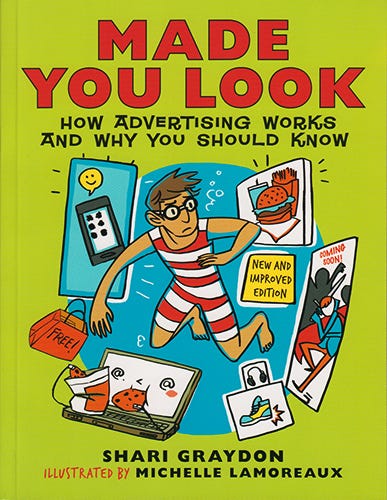
Made You Look: How Advertising Works and Why You Should Know
By Shari Grayden
Annick Press 2003
This is an old book, and it has been rendered perishable by
out of date references and changes in technology over the past ten years.
Nonetheless, I still deem this to be a very valuable resource. The
underlying information is still relevant, and the book remains a good guide to
thinking critically about advertising.
The liabilities of this book can be turned into assets. You
can have students update the archaic references with current information.
Students can also add in subsequent developments in advertising that the book
failed to anticipate. For example, students could assess how online advertising
has developed in the time since this book was printed. By undertaking these
tasks, students will practice using multiple sources, and make text to self,
and text to world connections.
The book engages active thinking about the information that
it presents by encouraging the reader to engage in activities throughout the text.
One such exercise is “Will Rodgers vs Winston
Churchill”. The following quotes are presented.
“Advertising makes you want spend
money you don’t have for something you don’t
want.”
Will Rodgers
“Advertising nourishes the
consuming power of men. It sets up… the goal of a better
home, better clothing, better food… It spurs individual
exertion and greater production.” Winston Churchill
After presenting these quotes, the readers are asked
questions about their personal experiences with advertisements and the feelings
and reactions that they provoked. Then, they are led to consider which quote
they agree with and why.
Metacognitive thinking processes are modeled throughout this
book as part of its structure. Oftentimes, books that encourage critical
thinking excel on encouraging students to assess the information that they are
given, yet they neglect to teach their readers to analyze their own thinking
process. This book excels on both counts.
There is also very good information on the historical
background and context of advertising.
Other notable subjects addressed in the book include…
Logo fashions
Cross promotional tie-ins How
& why ads are aimed at kids
Advertising in schools
Overall, the book gives a great break down of how you are targeted by ads, why you are
targeted, and what techniques are used to persuade you.
Once again, the examples used in the book are dated, but on
a fundamental level, the information is still very good. A student project to
update this book would be a fine means for students to cross over into
authorship. I would suggest chunking it into sections on the installment plan for either reading or project work.
By no means is this book perfect. It can get a little
tedious at times, and the format gets a little chunky; however, it still
compares favorably to other books that I have seen on the subject.
No comments:
Post a Comment
Note: Only a member of this blog may post a comment.